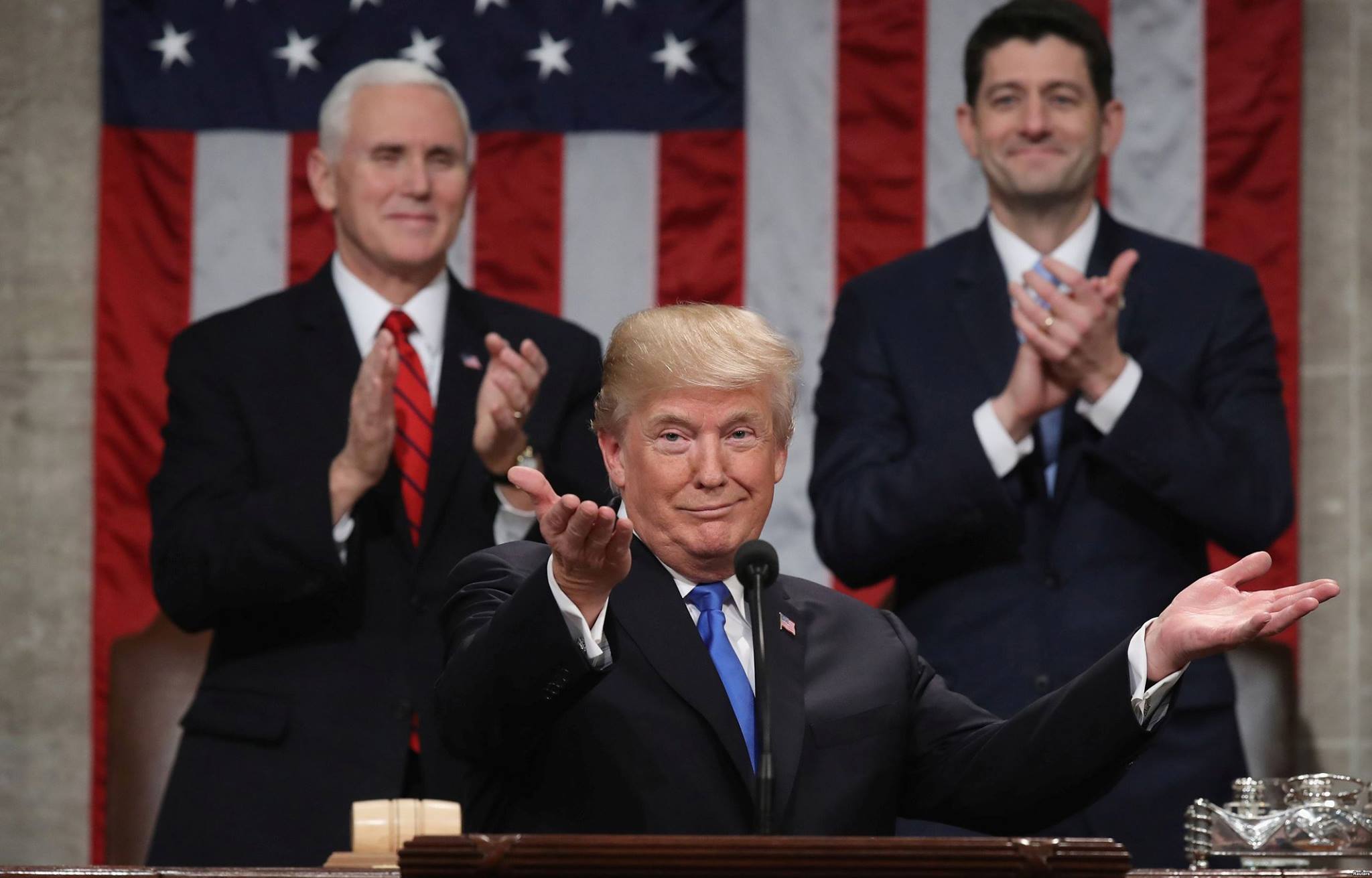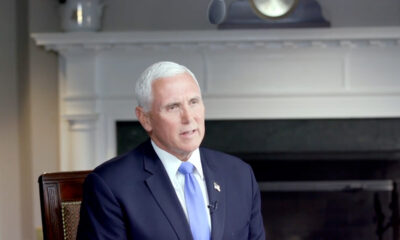Accountability
Trump Readies His First Second-Term Congressional Address
Donald Trump is preparing his next State of the Union address, and the world breathlessly anticipates how he will follow up on the lightning pace of his second administration.

The timing seemed perfect: The United States and Ukraine were slated to sign a mineral deal last Friday, which would have given President Trump another accomplishment to plug Tuesday night during his first address to Congress during his second term. Then the deal fell apart in spectacular fashion.
Trump can’t control Ukraine, but he can and does control the executive branch
Ukraine and the attitude of its leaders remain beyond Trump’s control. Six weeks into his return to the White House, however, the entirety of the executive branch is not. The president has used all available levers of power to remake the federal bureaucracy and government. Those who expected a more relaxed second term, hoping perhaps that a temporary exile tempered him, are disappointed.
There is no lame duck presidency, only what senior White House advisors charged with implementing his agenda call “Trump warp speed.” His address to Congress will highlight that work. The announced theme: “Renewal of the American Dream.”
Voters are divided on what they’re seeing so far. 48.6% approve of the way the president does his job compared to 47.4% who disapprove, according to the RealClearPolitics Average. Those numbers are on par with previous administrations and reflect the entrenched partisanship of a polarized nation. President Barack Obama, for instance, had a job approval rating of just 50.6% around this time in his second term. But the new numbers are an improvement for Trump: He was underwater at this point in his first term – more Americans, 49.9%, disapproved than approved, 44.1%.
Controlled chaos
Trump returns with the same unwillingness to play it safe that he exhibited during his first presidency. There is chaos, but a different, more controlled kind of chaos. Susie Wiles, his chief of staff, whom the president calls his “Ice Maiden,” has no patience for the kind of petty rivalries that defined and hindered his first four years. Instead, Wiles has insisted that all those who surround Trump must share his mission and commit to condemning backbiting and drama.
Wiles has delivered steadiness; Elon Musk, chaos, but only with the explicit blessing of the president. The Department of Government Efficiency, the brainchild of the eccentric billionaire who is officially “a special government employee” and who refers to himself as “tech support,” continues its long march through the administrative state.
Some agencies, like USAID, have been decimated, while others, like the Consumer Financial Protection Bureau, have been shuttered. “One of the biggest functions of the DOGE team,” Musk said last month, is ensuring Trump’s executive orders are carried out. This includes eliminating so-called diversity, equity, and inclusion policies and cutting the federal workforce, in some cases, to the bone. Errors have been made in haste. Musk admitted that funding for Ebola prevention had been “accidentally canceled,” only to be restored after the fact.
Elon Musk is time-limited, but Trump’s Cabinet is in place
“We will make mistakes. We won’t be perfect. But when we make a mistake, we’ll fix it very quickly,” he said during the first full cabinet meeting of the Trump administration. And this is on brand for an entrepreneur who famously said of cost-cutting in his business empire, “If you’re not adding back at least 10% of the things you cut, you haven’t cut enough.”
While no daylight exists between Trump and Musk, an expiration date could be looming. Special government employees are limited, by law, to working no more than 130 days a year. The president would have to then rely entirely on his Cabinet.
This is something of an accomplishment itself, given that Democrats were unable to stop a single major nomination, other than former Florida Rep. Matt Gaetz, who removed himself from contention to be attorney general. Despite the delay, Trump has managed to surround himself with those he sees as “the very best people” to run his administration. They have moved quickly.
Just like his administration has required federal employees to share five bullet points on their accomplishments each week, Trump is likely to deliver his own list before Congress, though the loquacious president often goes long. He spoke for one hour and 22 minutes during the 2019 State of the Union Address, just six minutes shy of the record for the longest speech, held by President Bill Clinton.
Will Trump set a record for his next SOTU?
Trump may intend breaking that record. The official White House schedule set aside two hours for the president to spend on Capitol Hill tonight. Tradition holds that night’s speech – the first of a president’s term – is not technically a State of the Union address. But it will have all the trappings. And he has a lot of material to work with.
Donald Trump was swept into office, in part, by a repeated promise to carry out the largest deportation effort in American history. Those efforts are ongoing, with DHS Secretary Kristi Noem and border czar Tom Homan focusing initial efforts on violent criminals, though Homan has warned that anyone crossing the border illegally is a criminal and “no one is off the table.” The initial result: a dramatic plunge in apprehensions at the U.S. Southern border from 250,000 per month at their peak under Biden to a small fraction of that under Trump.
“Border crossings since the day he took office are down 95%,” crowed White House Deputy Chief of Staff Stephen Miller. “I think it’s almost impossible to even describe the scale and scope of that achievement.”
The president likes to say that “tariff” is “the most beautiful word.” Trade wars, meanwhile, are no longer unprecedented, especially after Biden kept in place many of the Trump administration’s tariffs against China. The name of the game now is reciprocity. “Whatever countries charge the United States of America,” Trump said earlier this month, “we will charge them. No more, no less.”
Tariff policy already yields a dividend
While the reciprocal tariffs are set to start on April 2, the president announced punitive tariffs against both Canada and Mexico on the eve of his speech, 25% on both nations, given their failure, as he sees it, to do more to police illegal immigration and the flow of fentanyl.
More than a closed fist, Trump has described the policy as an open-handed invitation. Companies that make their goods stateside can avoid the tariff altogether. Some have already taken him up on his promise, most recently The Taiwan Semiconductor Manufacturing Co. At a White House press conference, TMCU executives stood next to Trump to announce a $100 billion investment in U.S. domestic chip manufacturing. News broke earlier in the day that Honda would build their Civic sedan in Indiana, rather than Mexico as planned, to circumvent the tariff.
Trump will likely point to those developments as evidence of his “golden age” in American manufacturing. All the same, stocks on Wall Street dipped at news that the trade war was about to hit a crescendo.
Inflation
As the administration moves quickly, Trump and his aides loathe what they see as a cursed inheritance. Inflation remains a nagging problem that the president has promised to fix. Democrats note that it hasn’t gone away under Trump. Republicans reply that fixing what Biden wrought will take more than six weeks.
Inflation now stands at 3.0% per the Consumer Price Index, down from a 9.1% high under the previous president. The way to bring it down, said top White House economic advisor Kevin Hassett, is to have both “an explosion of supply” and “a reduction in government demand.” Achieve both things, he told reporters last month, and “inflation goes way down.” They insist, of course, that this will take time.
The Trump foreign policy
Trump has moved fast on foreign policy. With the help of the Biden administration on their way out the door, Trump’s national security team brokered a ceasefire between Israel and the terrorist organization Hamas – threatening that “all hell would break loose” if the hostages were not freed. Seven of the subsequently released hostages are expected to travel to Capitol Hill this week.
The president longs to be remembered as “a peacemaker and unifier” and would very much like to win the Nobel Peace Prize. These ambitions make the aborted negotiations with the Ukrainians a bitter pill, according to White House officials. His calls for an end to the land war in Europe earned early praise from both French President Emmanuel Macron and British Prime Minister Keir Starmer. After kicking Ukrainian President Zelensky out of the Oval Office, prospects have dimmed.
Russian President Vladimir Putin is reportedly thrilled with the fallout. But Trump left the door ajar for Zelensky to return to the table for a minerals deal.
Trump: “We Could Have Rebuilt Our Entire US Navy” With The Money We’ve Given To Ukraine
REPORTER: What do you need to see from President Zelensky to restart these negotiations?
PRESIDENT DONALD TRUMP: Well, I just think he should be more appreciative because this country has stuck with them through thick and thin.
Trump: "We Could Have Rebuilt Our Entire US Navy" With The Money We've Given To Ukraine
REPORTER: What do you need to see from President Zelensky to restart these negotiations?
PRESIDENT DONALD TRUMP: Well, I just think he should be more appreciative because this country has… pic.twitter.com/E9Iv8fD8qW— RCP Video (@rcpvideo) March 3, 2025
This would allow the U.S. to mine resources in Ukraine and create what Trump sees as a foundation for peace. Piqued by criticism of his handling of the negotiations, the president wrote on social media Monday, “I am the only president who gave NONE of Ukraine’s land to Putin’s Russia,” a reference to Russian annexation under his Democratic predecessors.
Fireworks
When asked what he expects from the address to Congress, House Speaker Mike Johnson replied, “fireworks.” It was Johnson who invited Trump to make the address, and he heralded the president during a Fox News interview on Sunday for “doing what he said on the campaign trail he would do.”
Notably, those accomplishments are all the result of Trump’s pen and phone. He has moved the executive branch with extraordinary speed during his first six weeks. But Congress has inched forward at a glacial pace, and if his reforms are to be made permanent, they will need to be codified through legislation. Otherwise, a Democratic successor could just as easily reverse them. A more immediate bit of business looms: a March 14 deadline to fund the government. Negotiations over the rest of his legislative agenda, making permanent tax cuts from his first term, and border security continue.
Trump will talk about all of it Tuesday night at 9 p.m.
This article was originally published by RealClearPolitics and made available via RealClearWire.
Philip Wegmann is White House Correspondent for Real Clear Politics. He previously wrote for The Washington Examiner and has done investigative reporting on congressional corruption and institutional malfeasance.
-

 Civilization3 days ago
Civilization3 days agoDC Pipe Bomb Arrest Raises Questions About Christopher’s Wray’s FBI
-

 Civilization4 days ago
Civilization4 days agoThe Legal Logic Behind U.S. Operations Against Narco-Terrorist Networks
-

 Guest Columns5 days ago
Guest Columns5 days agoCongressional Leaders See Far Higher Stock Returns Than Peers
-

 Civilization5 days ago
Civilization5 days agoHow Trump Changed America
-

 Executive4 days ago
Executive4 days agoNewsom’s ‘National Model’ for Homeless Wracked by Fraud
-

 Executive3 days ago
Executive3 days agoWhen You’re in a Hole, Stop Digging
-

 Education2 days ago
Education2 days agoWaste of the Day: Taxpayers Subsidize Football Coach Severance
-

 Civilization2 days ago
Civilization2 days agoPence Calls on Trump To Fire RFK Jr Over Abortion Drug








